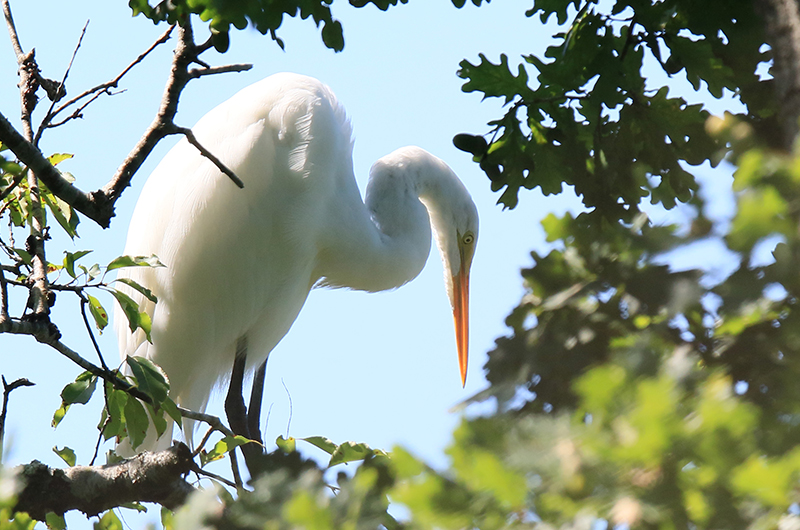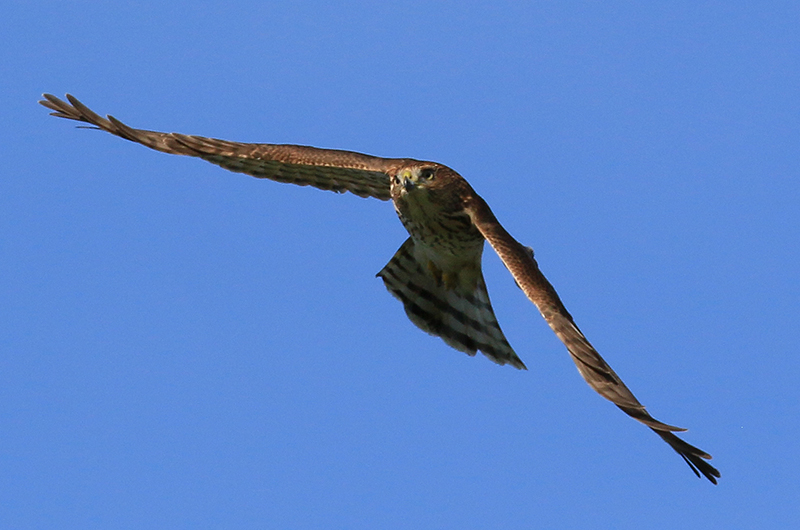Post Labor Day September has a luxurious feel to it. The weather is often ideal, and most of us have more time to enjoy the outdoors with the people we love. Such was my Sunday morning, Sept. 8, when a group of us gathered for the regular service at what I call The Church of Birds.
The congregation gathers at different locations weekly and may be just a devoted trio or as many as a dozen worshipers adorned in their best optics. There are no sermons at our service. Instead, we give thanks for the winged beings that we discover, bow our heads to our smartphones to take note with eBird and iBird, share laughs, and break bread or granola bars together. It’s a fellowship of feathers.
This week’s service was down at Katama and began with a bevy a beautiful bobolinks, at least 10, feasting on ragweed seeds behind a greenhouse at the Farm Institute. Bobolinks are Icterids, sharing their family with red-winged blackbirds, meadowlarks, other black birds, and the not-so-pretty cowbirds. Bobolinks molt from their spectacular black, white and buff colored breeding plumage to a buttery buff fall plumage that can make them challenging for new birders to identify.
Speaking of challenges, a flock of 17 brown-headed cowbirds loafing nearby included some confusing and sloppy looking immature birds that prompted a second look for identification. Shortly afterwards, we were treated to close flights by two different cooper’s hawks.
In a field near the Katama plains, our group found a large group of 14 Killdeer loafing and feeding with a few semipalmated plovers. Counting these similarly colored and ring-necked birds was a fun challenge in the spotting scope.
As we were driving along the cow pasture, Lanny McDowell, Pete Gilmore, Margaret Curtin and I were treated to the spectacle of a young starling picking flies from a Belted Galloway cow’s face. It was quite a-moo-sing.
Much like Wayne Smith and Kenneth LaVigne, I’ve been savoring the large flocks of migratory tree swallows foraging on the bayberry berries along the south shore. Lanny McDowell hopped out to get some images of a flock near Atlantic drive, and while we were all absorbed in viewing and counting the tree swallows, a peregrine falcon stooped in for a bite to eat. It was not successful in its hunt, but we were all excited to see this falcon at work.
A little while later, Soo Whiting spotted a merlin on the edge of the farm fields. Over at the Katama boat landing, we spent some time scoping the shore and seabirds at Norton Point. Highlights included a group of 5 lingering willet that appeared to include some juveniles, 52 black-bellied plovers and three short-billed dowitchers.
Bird Sightings
On Sept. 3, Warren Woessner birded Norton Point and found some large groups of migratory shorebirds, including 75 semipalmated sandpipers, 45 black-bellied plovers and 40 sanderlings.
Steve Allen continues to see some great birds at Felix Neck. On Sept. 5, his early birders group found 34 species, with highlights including eight great egrets and a flock of 35 black skimmers on Sarson’s island.
The following day, Steve reported 13 great egret and one snowy egret in a scrum before the remains of Dorian moved through. Other birds on the move that day were over 200 common grackles and some blue jays at Bert Fischer’s feeder.
Lanny McDowell found an American golden plover in the Katama area on Sept. 5 and 7 that is probably still around. If you need tips on distinguishing this plover from its cousin, check out the Martha’s Vineyard Bird Alert page on Facebook.
Jeff Bernier continues to spend quality time at Eel Pond in Edgartown and photographed the two remaining American oystercatcher families. Young oystercatchers take several months to learn how to catch and open their food, so they remain dependent on their parents longer than most other shorebirds.
Ending on a high note, on Sept. 10, Pete Gilmore reported a lark sparrow near the Aquinnah Cultural center while Walt Looney reported two marbled godwits at Eel Pond. With its long bill and buffy blush-colored feathers, this lovely and lithe shorebird is a show-stopper.
Soo Whiting’s book, Vineyard Birds II tells us that marbled godwits are a rare visitor, gracing our shores on only five visits from 1984 to 2007. I hope they stick around long enough for me to see them.
Luanne Johnson is a wildlife biologist and director of BiodiversityWorks in Vineyard Haven







Comments
Comment policy »